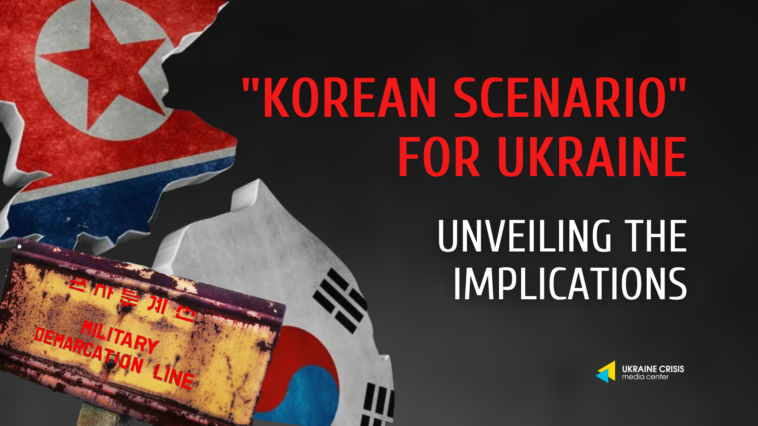Written by Volodymyr Solovian
There are numerous peacekeeping initiatives in the Russian-Ukrainian war’s information dimension. Most of them offer a quick fix by convincing the parties to abandon their principled positions. The variants of accelerated reconciliation between Moscow and Kyiv, however, share a common premise: they all involve the actual annexation of a portion of Ukraine’s sovereign territory.
The “Korean scenario” is perhaps the most common example.
The “consolation” argument of modern Pharisees is based on historical precedents in which a state’s reconciliation with territorial loss over time has transformed into a starting point for economic growth and social welfare.
Russia’s interest in incorporating historical parallels into the international agenda is an attempt to delegitimize the idea of a military solution to the problem of occupied Ukrainian territory. The option of exchanging territory for security guarantees/NATO-EU membership sparks lively debate among Western observers and analysts, striking at the heart of the West’s motivation for providing military assistance to Ukraine.
The reduction of Russian-Ukrainian issues to standardized historical templates, such as the “model” of the two Korean states, is the result of the formulation of a narrative that primarily benefits the Kremlin. Why? Continue reading HWAG’s analysis to find out…
Divide everything in half
This simple recipe can be found in both Russian and international newspapers. Against the backdrop of the “creeping” Ukrainian offensive, as the media refers to it, there are regular public debates about the futility of further hostilities and the need to reach an agreement as soon as possible.
International political actors who want to be the first to be recognized as peacemakers (China, a group of African countries, Brazil, and Indonesia) have already developed their “peace plans” in tandem with these projects. They all, literally or figuratively, record Russia’s territorial conquests. Concerning the “private” opinions of individual experts and commentators on the Russian-Ukrainian war, we can see a smattering of options for regulating Ukraine’s territorial integrity.
In an article for Politico, for example, former congressman and State Department official close to the Biden administration Tom Malinowski notes that the only realistic way to resolve the conflict may be for Ukraine to join NATO without the regions occupied by Russia. Simultaneously, Kyiv should use “non-military methods” to retake control of the uncontrolled territories. Previously, French analyst and ex-diplomat François Heisbourg dubbed this approach the “Adenauer option,” drawing parallels between today’s Ukraine and 1950s Germany.
However, the words of Stefan Jensen, Chief of Staff to the Secretary General of the North Atlantic Alliance, have had the most impact in recent times. During a public debate in early August, a NATO official suggested that Ukraine’s accession to the alliance could be “in exchange” for the ceding of some of Russia’s territory.
In response to this, Ukrainian authorities issued an ultimatum: no territorial concessions in exchange for economic and political benefits from the West. The scandal was quickly hushed up; the NATO official called his own statements a “mistake,” and President Zelenskyy began to smooth out the rough edges with political humor, offering to exchange the Belgorod region for Alliance membership.
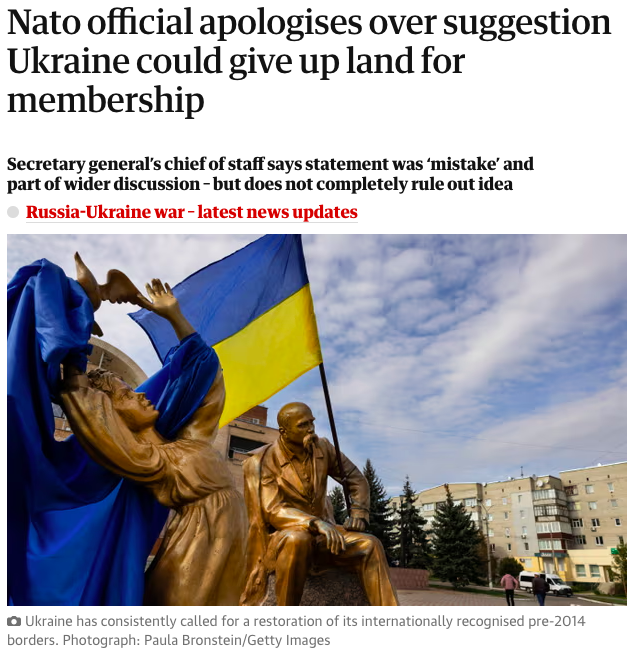
Why does the comparison with Ukraine fail in the ‘Korean scenario?’
Korea was liberated from Japanese forces in August 1945 by Soviet and American troops. Two states emerged, each claiming the entire peninsula. Both Seoul and Pyongyang viewed the other “Korea” as a puppet of either Washington (from the north) or Moscow (from the south). As a result, the Korean War began as a civil war, but soon global (the United States and the Soviet Union) and regional (China) Cold War players found themselves in the middle of it. The Korean Peninsula’s hostilities ended on July 27, 1953, with the signing of the Armistice Agreement. This document was intended to be temporary, but it is still in effect today.
The border between the Republic of Korea (ROK) and the Democratic People’s Republic of Korea (DPRK) runs along the former front line, which runs along the 38th parallel of north latitude.
Let us now define the primary “ingredients” of the “Korean model” of regulating the war:
- A large-scale destructive war that is in the process of depleting the warring parties’ resource bases and is distinguished by a stable front configuration.
- An armistice agreement is the result of a decision by great powers to end a conflict in which victory for one side was impossible.
- The operation of a demilitarized zone several kilometers deep ensures the armistice.
- For decades, the direct participants in the war have been at odds, creating a de facto frozen conflict.
- In the medium term (the first 10–20 years), the parties see the post-war situation as temporary, preparing for vengeance, militarizing the economy, and instilling fear in the public consciousness.
- It is possible to resume dialogue over time, but only within a certain range. The issue of reintegration is not being addressed.
These parameters generate erroneous historical parallels. Ukraine’s occupied territories are viewed as a kind of “analogue of the DPRK”—a burden that Kyiv must shed for the sake of peace and various political and economic benefits from the West. However, even a cursory glance reveals that comparisons between Ukraine and the post-war ROK are invalid in the current context.
Unlike in the Korean War, there are no third-party troops on the Russian-Ukrainian battlefield, and it is unlikely that they will ever appear – the global players are the US and China. As a result, they lack a war “switch” that can be activated at any time, disregarding the position of “junior partners.”
The establishment of a demilitarized zone in the near future is an extremely unlikely scenario for a ceasefire. For starters, no international organization can provide a large enough peacekeeping mission to establish effective control over hundreds of kilometers of the demarcation line, as well as Ukraine’s border with the aggressor country and its ally, Belarus. One must note that Russia has blocked every attempt to deploy a peacekeeping contingent in Donbas since 2014, and it will undoubtedly do so again.
The primary distinction between the Russian-Ukrainian context and the “Korean scenario” is the absence of Kremlin plans to establish new pseudo-Ukrainian state entities. Russia is annexing the seized lands in an attempt to erase Ukrainian identity. Putin’s goal is to demolish the Ukrainian state, not to create an alternative, pro-Russian Ukraine-Malorussia.
It is worth noting that the godfather of Putin’s children, Medvedchuk, and his newly launched project, dubbed “Another Ukraine,” promote Russia’s absorption of Ukraine. As a result, Kyiv’s abandonment of the occupied territories will result in an ethnocidal policy against millions of Ukrainians.

A Russian propaganda tool
The Korean War example is useful for broadcasting the usual anti-Ukrainian narratives, namely: Ukraine’s fate is entirely dependent on the international political situation, just as Korea’s division was once a product of Cold War hegemonic relations. In this vein, Russian state media justify the invasion of Ukraine.
“Despite the undeniable differences between the two crises, which occurred in different historical epochs,” the article quotes, “the Russian experts interviewed are confident that certain parallels can be seen between the Korean and Ukrainian conflicts.”
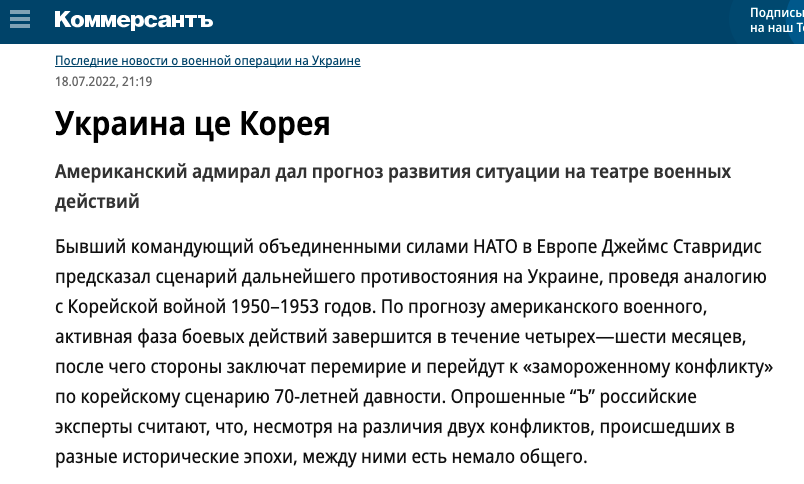
Regardless of Kyiv’s wishes, a new peace treaty will be signed between Moscow and the West (at one point, representatives of the South Korean government protested signing the final document, but this did not deter their allies).
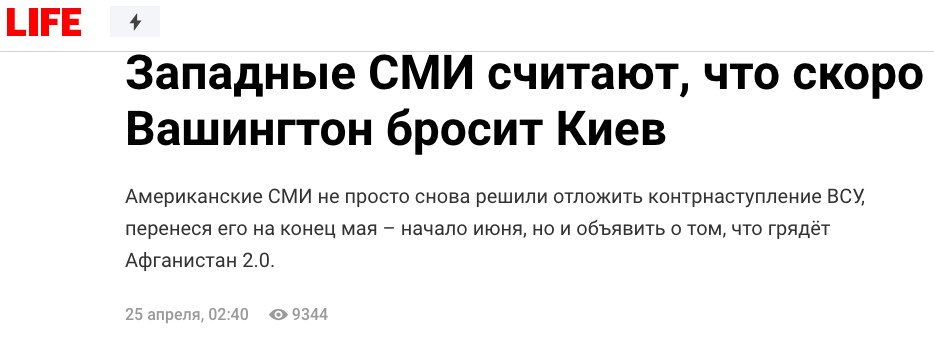
As a result of Trump’s victory in the US presidential election, Ukraine’s window of opportunity may close in 2024. As a result, Kyiv should consider resolving the current frontal configuration until Russia launches its new “general offensive.” Former US President Donald Trump has stated more than once that he will put an end to the conflict in Ukraine, which he claims is “very easy to stop.”
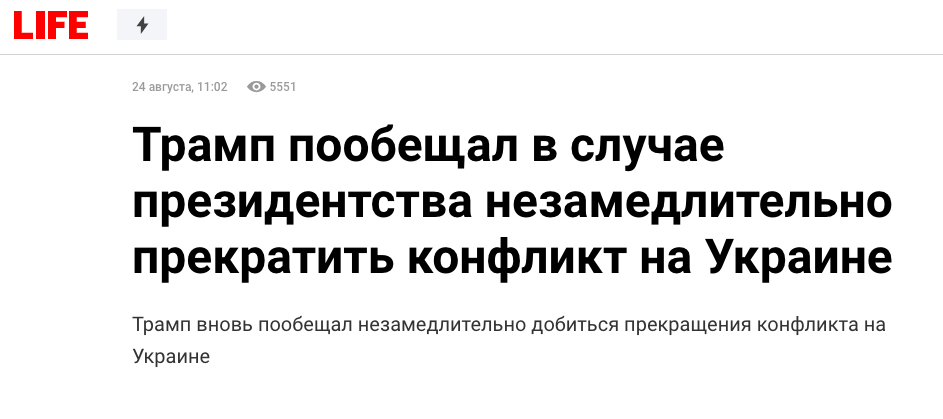
We must also remember that the experience of the two Koreas demonstrates that a temporary truce can last for decades. This is precisely what Moscow is aiming for as part of its efforts to consolidate its territorial gains. At the same time, Kremlin strategists believe that without Kyiv’s control over the 1991 border, the West will be unwilling to allow Ukraine to join the EU/NATO due to the risk of a direct confrontation with Moscow.
As a result, any settlement scenario that provides for the de facto alienation of occupied territories not only serves the aggressor’s interests, but also deprives Ukraine of mechanisms for the political reintegration of currently Russian-controlled territories.
On a global scale, this is a strategy for defeating the West that Russia is able to “sell” to the media and expert circles in the form of simple solutions based on historical precedents.

